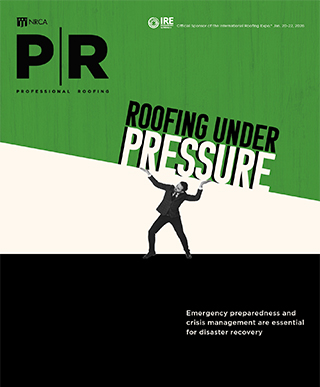Normalize conversations about mental health among co-workers

A study conducted by Construction Dive from 2018-24 reported anxiety among construction workers grew from 12.6% to 18.4% and depression increased from 7.7% to 8%.
Additionally, the share of workers who said they needed mental health care but could not afford it rose from 2% to 5.6%.
In 2023, there were about 5,000 construction worker deaths by suicide and nearly 16,000 overdoses.
And a recent webinar conducted by CPWR-The Center for Construction Research and Training discussed the effects of suicide and overdoses on job sites and the need for workplace interventions. CPWR urged contractors to use tools such as mental health training, opioid awareness programs and alternative pain-management guides, as well as to normalize conversations about mental health.
The webinar highlighted that workplace culture can change when workers are willing to help peers and talk to each other about mental health issues.
“The more you encourage [construction workers] to engage with their co-workers and be a friend and be the helper, then I think that breaks down some barriers,” says Amber Trueblood, CPWR’s data center director. “The more they talk amongst themselves about it and the more they try to help their co-workers, the more likely they will be down the road to seek help if they need it.”
CPWR also co-branded industry guidelines regarding suicide prevention language and offers downloadable infographics for workers and employers at cpwr.com/research. NRCA’s mental health resources are available at betoughenough.org.
How to protect your business before selling
Planning and preparation before selling a business can be a challenge. Along with the mixed emotions of letting go of a business they have built, owners also want to be sure the sale will be the best for the company and its employees.
Inc. shares the following strategies to help protect your business when you are planning to sell.
- Know the real workload. Many company owners underestimate the time and energy needed to sell a business. As a result, daily business operations can suffer when leadership is involved with time-consuming meetings related to the sale, which can affect the final valuation and put the seller in a more precarious position.
- Build operational resilience. Work to ensure your business can run without your constant attention. Establish clear accountability structures and document processes for your team. You want to be able to show your business can thrive when you are minimally involved to help increase buyer confidence.
- Conduct mock due diligence. Rather than scrambling to find documents for potential buyers, be proactive and gather all necessary paperwork—such as contracts, financial statements, customer agreements and operational data—to have available in a well-organized place. You also could ask your accountants to perform a “quality of earnings” review to identify potential issues before negotiation begins.
- Assemble an experienced transaction team. A knowledgeable team is crucial to a successful sale. Author Bruce Eckfeldt, a strategic business coach and Inc. 5000 CEO, recommends using “an investment banker familiar with your industry’s valuation models; a mergers and acquisitions attorney who closes deals regularly; a transaction-experienced accountant; and a personal wealth adviser who understands the tax implications of various deal structures.”
Essential skills for modern leaders

Gallup reports employee engagement hit a 10-year low in 2024, with only 31% of employees engaged. Leadership is not just about intelligence, authority and experience. Leaders need skills that build trust and keep people connected and engaged.
In an Inc. article, author Christie Smith, founder of the Humanity Studio, shares the following “power skills” all modern leaders need to succeed in the current work environment.
- Suspend self-interest. Leaders must have integrity and make decisions that are transparent, fair and driven by values. Smith says: “Trust is the foundation of high-performing teams, and it starts with leaders who put people and purpose ahead of personal gain. Great leaders do not seek control for its own sake. They focus on serving their teams, ensuring that decisions benefit the organization and its people—not just their personal ambitions.”
- Master curiosity and context. Excellent leaders take time to understand their team members’ strengths, motivations and aspirations. Leaders who know their people well can connect them to meaningful work, which boosts engagement, trust and retention.
- Build psychological safety. When employees do not feel comfortable speaking up, sharing ideas and taking risks, they disengage. Great leaders communicate openly, admit their mistakes and encourage honest conversations so people feel valued and heard.
- Stay emotionally agile. When pressure is on, the best leaders do not panic; instead, they adapt, regulating their emotions and engaging their teams to make thought-ful decisions. “When leaders stay steady and engage their teams in decision-making, they build trust, even in the toughest moments,” Smith says.
- Make excellence a habit. Small, consistent actions can lead to long-term transformation. Excellent leaders demonstrate clarity, consistency and commitment daily, which can have strong, lasting effects.
Labor shortage in construction is main cause of project delays
A workforce survey conducted by the Associated General Contractors of America and National Center for Construction Education and Research shows construction workforce shortages are the leading cause of project delays, according to AGC.
Ninety-two percent of construction companies that are hiring report having difficulty finding qualified workers. Eighty-eight percent of companies report having openings for craft construction workers, and 80% have openings for salaried workers.
Fifty-seven percent of companies report available candidates are not qualified because they lack essential skills or do not have an appropriate license. Also, only 10% of firms use the H-2B visa program or other temporary work visa programs to hire salaried or hourly craft employees.
The survey shows new immigration enforcement efforts have affected nearly one-third of construction companies. Twenty-eight percent of respondents report being affected by immigration enforcement activities during the past six months; 5% report a job site or offsite location was visited by immigration agents; 10% say workers left or failed to appear because of actual or rumored immigration actions; and 20% report subcontractors lost workers.
Worker shortages are survey respondents’ most common reason for project delays. Forty-five percent of respondents report experiencing project delays because of their own shortages or subcontractors’ worker shortages. Seventy-eight percent of companies report at least one project has been delayed during the past 12 months.
Contractors are trying to combat the labor shortage. Seven out of eight firms raised base pay for workers as much or more than they did a year earlier, and 42% initiated or increased spending on training and professional development during the past year. Additionally, 55% of companies used online strategies such as social media and digital advertising to connect with younger applicants, and 52% engaged with career-building programs at high schools, colleges, or career and technical education institutions.
Nearly 1,400 companies completed the Workforce Survey from a broad cross-section of the construction industry.



